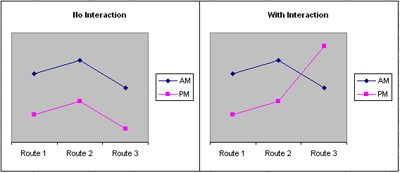Definition
In some experiments, we may find that the difference in the measured outcome corresponding to the levels of one factor is not the same at all levels of the other factor(s). In other words, the effect of one treatment varies according to the levels of the other treatment(s). When this occurs, there is a combined effect between the Factors. This is also referred to as an interaction.
Examples

The simplest way to see an interaction effect is by graphing the responses at the levels of the different factors with respect to each other. Consider the two graphs shown.
Both depict the time to get to a certain place using each of three routes at different times of day (AM or PM). The chart on the left shows the two lines for AM and PM follow the same pattern, with each segment parallel between them. This means that the change in the time taken to reach the destination is the same across AM and PM no matter which route you take - there is no interaction between the two factors Route and Time of Day.
The chart on the right shows the same lines but this time the segments are not parallel. Thus, the change in the time taken to reach the destination varies according to route and time of day the trip is undertaken. In particular, both route 1 and 2 have longer times in the AM, but route 3 has a longer time for the PM. This suggests a combined effect (interaction) between route and time of day for travel.
